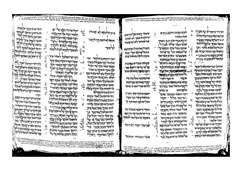Jeremiah 30
| Jeremiah 30 | |
|---|---|
|
Book of Jeremiah in Hebrew Bible, MS Sassoon 1053, images 283-315. | |
| Book | Book of Jeremiah |
| Bible part | Old Testament |
| Order in the Bible part | 24 |
| Category | Nevi'im |
Jeremiah 30 is the thirtieth chapter of the Book of Jeremiah in the Hebrew Bible or the Old Testament of the Christian Bible. It is numbered as Jeremiah 37 in Septuagint. This book contains the prophecies spoken by the prophet Jeremiah, and is a part of the Books of the Prophets.[1][2]
Text
- The original text is written in Hebrew language.
- This chapter is divided into 24 verses.
Textual versions
Some most ancient manuscripts containing this chapter in Hebrew language:
- Masoretic Text (10th century)
- Dead Sea Scrolls: (2nd century BC)[3][4]
- 4QJerc (4Q72): extant: verses 6‑9, 17‑24
Ancient translations in Koine Greek:
- Septuagint (3rd century BC; different verse numbering)
- Theodotion version (~AD 180)
Structure
NKJV groups this chapter into:
- Jeremiah 30:1-24 = Restoration of Israel and Judah
Verse 10
- ‘Therefore do not fear, O My servant Jacob,’ says the Lord,
- ‘Nor be dismayed, O Israel;
- For behold, I will save you from afar,
- And your seed from the land of their captivity.
- Jacob shall return, have rest and be quiet,
- And no one shall make him afraid. (NKJV)[5]
- "Do not fear": a common phrase in prophecy of salvation (Genesis 15:1; Isaiah 35:4; Isaiah 43:1).[6]
- "My servant": this terminology for Israel parallels that of Isaiah 42:1 and Isaiah 44:1.[7]
Verse 11
- For I am with you,’ says the Lord, ‘to save you;
- Though I make a full end of all nations where I have scattered you,
- Yet I will not make a complete end of you.
- But I will correct you in justice,
- And will not let you go altogether unpunished.’ (NKJV)[8]
Verse numbering
The order of chapters and verses of the Book of Jeremiah in the English Bibles, Masoretic Text (Hebrew), and Vulgate (Latin), in some places differs from that in Septuagint (LXX, the Greek Bible used in the Eastern Orthodox Church and others) according to Rahlfs or Brenton. The following table is taken with minor adjustments from Brenton's Septuagint, page 971.[9]
The order of CATSS based on Alfred Rahlfs' Septuaginta (1935), differs in some details from Joseph Ziegler's critical edition (1957) in Göttingen LXX. Swete's Introduction mostly agrees with Rahlfs edition (=CATSS).[9]
| Hebrew, Vulgate, English | Rahlfs'LXX (CATSS) | Brenton's LXX |
|---|---|---|
| 30:1-9,12-14,16-21,23-24 | 37:1-9,12-14.16-21,23-24 | |
| 30:10,15,22 | none | |
| 49:1-5,23-27,28-33 | 30:1-5,29-33,23-28 | 30:1-5,23-27,28-33 |
See also
Notes and references
- ↑ J. D. Davis. 1960. A Dictionary of The Bible. Grand Rapids, Michigan: Baker Book House.
- ↑ Therodore Hiebert, et.al. 1996. The New Interpreter's Bible: Volume: VI. Nashville: Abingdon.
- ↑ Timothy A. J. Jull; Douglas J. Donahue; Magen Broshi; Emanuel Tov (1995). "Radiocarbon Dating of Scrolls and Linen Fragments from the Judean Desert". Radiocarbon. 38 (1): 14. Retrieved 26 November 2014.
- ↑ Ulrich 2010, p. 575-576.
- ↑ Jeremiah 30:10
- ↑ The New Oxford Annotated Bible with the Apocrypha, Augmented Third Edition, New Revised Standard Version, Indexed. Michael D. Coogan, Marc Brettler, Carol A. Newsom, Editors. Publisher: Oxford University Press, USA; 2007. p. 1125-1126 Hebrew Bible. ISBN 978-0195288810
- ↑ The Nelson Study Bible 1997, p. 1277-1279.
- ↑ Jeremiah 30:11
- 1 2 (CCEL - Brenton Jeremiah Appendix)
Bibliography
- The Nelson Study Bible. Thomas Nelson, Inc. 1997. ISBN 9780840715999.
- Ulrich, Eugene, ed. (2010). The Biblical Qumran Scrolls: Transcriptions and Textual Variants. Brill.
